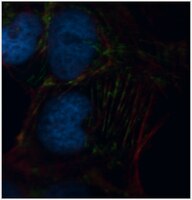MABE992 Sigma-AldrichAnti-Septin-9 Antibody, clone 10C10
This Anti-Septin-9 Antibody, clone 10C10 is validated for use in Western Blotting, Immunocytochemistry, Immunoprecipitation for the detection of Septin-9.
More>> This Anti-Septin-9 Antibody, clone 10C10 is validated for use in Western Blotting, Immunocytochemistry, Immunoprecipitation for the detection of Septin-9. Less<<Recommended Products
Overview
| Replacement Information |
|---|
Key Spec Table
| Species Reactivity | Key Applications | Host | Format | Antibody Type |
|---|---|---|---|---|
| H | WB, ICC, IP | M | Purified | Monoclonal Antibody |
| References |
|---|
| Product Information | |
|---|---|
| Format | Purified |
| Presentation | Purified mouse monoclonal IgG1κ in buffer containing 0.1 M Tris-Glycine (pH 7.4), 150 mM NaCl with 0.05% sodium azide. |
| Quality Level | MQ100 |
| Physicochemical Information |
|---|
| Dimensions |
|---|
| Materials Information |
|---|
| Toxicological Information |
|---|
| Safety Information according to GHS |
|---|
| Safety Information |
|---|
| Storage and Shipping Information | |
|---|---|
| Storage Conditions | Stable for 1 year at 2-8°C from date of receipt. |
| Packaging Information | |
|---|---|
| Material Size | 100 μg |
| Transport Information |
|---|
| Supplemental Information |
|---|
| Specifications |
|---|
| Global Trade Item Number | |
|---|---|
| Catalogue Number | GTIN |
| MABE992 | 04055977314946 |
Documentation
Anti-Septin-9 Antibody, clone 10C10 SDS
| Title |
|---|
Anti-Septin-9 Antibody, clone 10C10 Certificates of Analysis
| Title | Lot Number |
|---|---|
| Anti-Septin-9, clone 10C10 - 3494025 | 3494025 |
| Anti-Septin-9, clone 10C10 - 3923528 | 3923528 |
| Anti-Septin-9, clone 10C10 - 4082550 | 4082550 |
| Anti-Septin-9, clone 10C10 -Q2642762 | Q2642762 |









